Curated OER
Sense of Sound Lesson
Students listen to the book Sense of Sound and discuss the different things that they can hear. In this sound lesson, students listen to the book, and then close their eyes as the teacher makes different noises and the students guess...
Curated OER
The Grating Spectrometer; Light and Wavelengths
Students create a paper model that demonstrates wave interference for 3 wavelength from 2 sources. For this light and wave lesson, students use a real spectrometer and observe and measure the wavelength of spectral lines. Students then,...
Curated OER
Reflection, Refraction & Lenses
High schoolers are able to describe what happens to light when it strikes different materials. They describe the law of reflection. Students are able to explain why a mirror froms a virtual image. They are able to describe diffuse...
Curated OER
It's a Gas!
Students investigate gases and their properties by completing 4 activities. In this gases lesson plan, students perform activities to show that gases take up space, they diffuse, and that odors and vibrations pass through gases. They...
Curated OER
Light
Fifth graders sit in their seats with the lights on and then the teacher turns off the lights. After their eyes have adjusted, they vote on what colors of construction paper are being held up. The lights are then turned back on and...
Curated OER
Pulse-Width Modulation Signal Generator
In this electrical activity, students answer a series of 6 open-ended questions about pulse-width signal generators. This activity is printable and the answers are revealed online.
Curated OER
Immigration; The New Colossus
Seventh graders explore The New Colossus by Emma Lazarus. In this The New Colossus lesson, 7th graders read the poem and analyze its meaning. Students discuss what the poem means about American culture and why it was engraved on the...
Curated OER
Gifts from the Sea
Students discover the oceanic food chain. In this healthy eating lesson, student investigate the fish we eat and the food the fish eat. Students discover what ocean animals eat seaweed and what everyday foods we eat that also...
Curated OER
The Universe
Learners describe what scientists mean by an "expanding universe" in their own words. They explain how scientists comprehend the universie is expanding. Students comprehend the vast scale of the universe. They comprehend how theory...
Curated OER
Get Real!
Students reach a consensus as to what makes a good reality-based TV show. They create their own scenarios for a new such show, and critique it, based on the criteria the class establishes.
Curated OER
The Sonnet Challenge
Students are given information about two popular sonnet forms-English and Italian. They are given the rules for writing a sonnet. Students are asked what type of sonnet they would use. They are each given a sheet of paper and asked...
Curated OER
The World’s Longest Bridge
In this comprehension learning exercise, students read a story and answer the six multiple choice questions that follow. They identify the longest bridge in the world, what happened during construction, and what possible dangers to the...
Curated OER
Chain Letters and Pyramid Schemes
In this statistics lesson, high schoolers analyze chain letters and draw conclusions of the outrageous amount of letters that would be mailed out if people really followed through. This is more of a thought provoking learning exercise...
Curated OER
Natural Disasters
Students read the book "Tsunami!" and discuss natural disasters and how they can prepare. This lesson is much more than a study of tsunamis. The lesson is chock-full of ways to study the Japanese culture across the curriculum. There are...
Curated OER
World Oceans Day in the Classroom
The ocean is a fascinating topic for students to cover.
Curated OER
Regolith Formation
Students study what regolith is and how it contrasts with weathering on Earth. In this weathering lesson students divide into groups, hypothesize and confirm their guesses.
Curated OER
Hurricanes
Upper elementary meteorologists take a glance at what a hurricane is and how it is formed. Because this does not get into the differences in air pressure that drive the associated winds, it may not be useful for older learners. The...
Curated OER
English Exercises: Mysteries of Anatomy
Consider this online interactive activity as a way to practice the names that often accompany human anatomy, such as the crown of the head and the roof of the mouth. Learners select an anatomy word with a double meaning from a drop-down...
Curated OER
Radio
Students explain in their own words how radios work. In this technology lesson, students discuss the importance of radio today. They differentiate AM and FM bands.
Curated OER
Sound
Second graders investigate the production of sound through experimentation. Working in pairs, 2nd graders receive supplies to create a sound machine. Once they create their machine and record the differences in the sounds produced.
Curated OER
Lesson- Colors of Stars
Student describes what happens to the color of a stove burner or a coal as it gets hotter. They use the applet to determine what range of temperatures range give you a red light, what range of temperatures would give you a white light,...
British Council
Weather 2
Young meteorologists answer questions based on the types of weather they experience in the region they live. They also complete a word search to find weather-related terms.
Houghton Mifflin Harcourt
Nature: Friend and Foe: English Language Development Lessons (Theme 6)
If readers don't understand key portions of a text, it may seem more like a foe than a friend. The second resource in a series of three ESL lessons designed to accompany the texts in Nature: Friend or Foe makes the texts easier to...
National Nanotechnology Infrastructure Network
Small Scale Stenciling: Mask Lab
Investigate the procedure for developing computer chips! Learners use solar print paper to create both positive and negative images. They observe the effects of single and multiple exposures and compare results.























